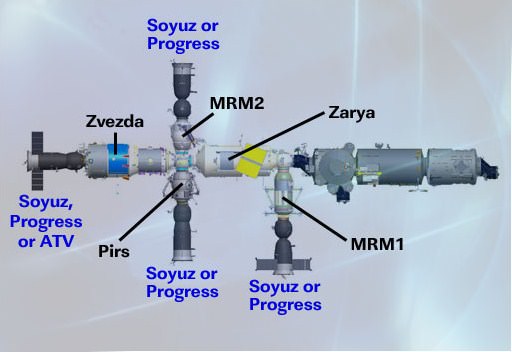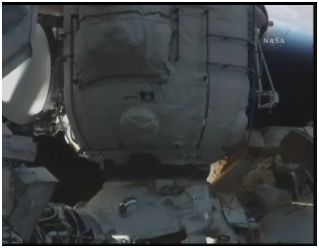[/caption]
A 8,550 kg (17,760-pound) Russian Mini-Research Module, known as Rassvet or “Dawn,” was attached to the International Space Station today. This is the first (and last) Russian-built module to be delivered by a space shuttle, and the 8 meter long (20 ft) 2.5 meter (8 ft) diamater module will serve an area for scientific research, as well as for stowage and a docking port extension for future visiting spacecraft such as the Soyuz and Progress resupply vehicles.
“The ISS has grown by one more module,” Moscow mission control radioed up the crew. “We are really very grateful to you. And our congratulations to all of you for this new step in space research and thanks for all your effort and all your work.”
The MRM is packed full of 1,400 kg (3,086 pounds) of NASA equipment and supplies, plus an experiment airlock and European robot arm equipment that will be attached to other modules later.

MRM was docked to the Earth-facing port of the central Zarya module, and will provide needed clearance between the forward Russian docking port and a US storage module, the Permanent Logistics Module, scheduled to arrive at the station later this year.
Operations began early this morning to install the MRM, with Atlantis commander Ken Ham and pilot Dominic Antonelli, operating the shuttle’s robot arm to take the new module from the shuttle’s cargo bay. Then astronauts Garrett Reisman and Piers Sellers installed the MRM-1 on Zarya, — appropriately waiting until orbital sunrise to attach the module with great precision. Controllers said Reisman maneuvered the module so precisely, he made a “hole in one.”

Now that the MRM is attached, the ISS and shuttle astronauts now turn their attention to the second spacewalk of the mission scheduled for Wednesday, May 19 to be conducted by Steven Bowen and Michael Good. The primary tasks are the removal and replacement of P6 truss batteries that store solar energy. These batteries have outlived their expected lifespan of 6 years, so the batteries will be swapped out with new ones.
Behind the scenes work has also been ongoing to develop a task to clear a cable that is pinched out on the end of the Atlantis’ boom and sensor system that prevented an inspection of the shuttle’s thermal protection system. NASA TV commentator Kyle Herring said the procedure appears to be a fairly straightforward task to clear the cable out of the way and secure it with a wire-tie. Mission planners are seeing where the procedure fits in best with the rest of the spacewalks tasks.

